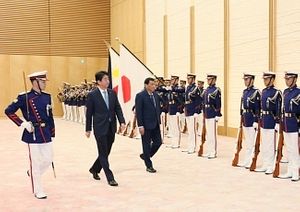This week, the Philippines disclosed that it would receive three more aircraft from Japan next week. The anticipated delivery would conclude a deal that constitutes both a boost for Manila’s limited military capabilities as well as a gain for the bilateral defense relationship between the two countries that has broader regional implications as well.
As I have noted before, Japan-Philippines defense ties under Rodrigo Duterte have continued strengthening amid some uncertainties and refocusing as part of their broader partnership (See: “Japan-Philippines Defense Relations Under Duterte: Full Steam Ahead?”). Despite the challenges the relationship has faced, the strategic rationale for both sides remains clear, with Japan looking to boost ties with Southeast Asian states including in the defense realm, and the Philippines eying ways to strengthen its limited military capabilities to address a series of threats ranging from terrorism to the South China Sea (See: “Where is the Philippines Coast Guard in its Military Modernization?”).
Though Japan’s defense assistance to the Philippines includes several lines of effort, from capacity-building to equipment transfer, one of these is the agreement for the Japan Maritime Self Defense Forces (JMSDF) to donate five Beechcraft TC-90 trainer aircraft to Manila. As I have noted in these pages, the TC-90s deal was significant because it was a first instance of Japan transferring excess defense equipment to another country free of charge following ongoing changes in its domestic laws and it was a major boost for Manila given its limited ability to conduct regular and extensive patrols of the South China Sea (See: “Why Japan’s New Military Aircraft Gift to the Philippines Matters”).
Following multiple rounds of discussions, things began to kick off in late 2016 and early 2017, with rounds of training for Philippine naval pilots starting and then the first two of the TC-90s delivered in March 2017. Along the way, the initial agreement to lease the aircraft was amended to a donation, which was a more favorable arrangement for the cash-strapped Philippines. The first TC-90 was officially commissioned into service in late November and has since been used including in the deployments to the South China Sea. The second one was commissioned on March 19 at the Naval Air Group headquarters at Sangley Point, Cavite City.
The three other aircraft were also set to be donated sometime this year. And on Wednesday, reports surfaced that the Philippines had confirmed that Japan would be giving the other three aircraft to Manila next week. Philippine Navy spokesperson Lued Lincuna said that the transfer would take place on Monday in a ceremony at a naval base, effectively completing that part of the deal between the two sides.
Assuming that occurs as scheduled, it would no doubt be yet another occasion to reflect on the significance of the deal itself for both sides as well as for the region more generally given the broader dynamics at play.

































